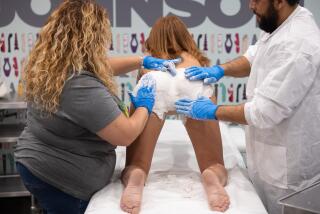Companies Discover America : Some Manufacturers Are Bringing Their Production Home
SAN LUIS OBISPO — Greg Hind got tired of the hassle. The windbreakers and anoraks that his company makes for joggers and bicyclists were coming from the Taiwan factory with holes, unfinished seams and unclipped yarns.
Managers were flying frequently to Taiwan to monitor production. Faxes with design modifications were speeding back and forth. Delays were hampering deliveries to U.S. retailers. And workers at Hind Inc.’s headquarters here were spending so much time making last-minute repairs that any savings from the cheaper overseas labor costs were evaporating.
Fed up, company founder and Chief Executive Hind recently called it quits in Taiwan, Costa Rica and some South American nations, where a total of about 10% of the company’s products were made.
“Our intention is to bring everything back,” he said in a recent interview. As it builds sales, the company anticipates adding 60 jobs this year at plants in California, Washington and Oklahoma.
With all the talk of America’s shrinking manufacturing base and renewed interest in “buying American,” some companies--from sportswear makers to basketball manufacturers--are shifting jobs back to U.S. soil.
But don’t think that manufacturers are suddenly wrapping themselves in the Stars and Stripes. This is about profit, not patriotism. With cash-strapped retailers reluctant to place orders far in advance, manufacturers are being forced to speed delivery times, and proximity to markets is key.
And by having production closer to home, they can keep better tabs on quality.
“Quick response is changing the business,” said Rosalind Wells, an economist with NPD Group, a market research firm in Port Washington, N.Y.
The shift does not mean that a flood of jobs will soon be washing onto U.S. shores to replace the thousands lost in auto, steel, defense and furniture manufacturing in recent years. The United States lost an estimated 1 million production jobs from 1989 to 1991--thousands of them to overseas plants--and the Bureau of Labor Statistics foresees no net gains before the end of the century in the current U.S. base of 18 million such jobs.
But some work should at least trickle back as small- and medium-size manufacturers seek to get more control over quality and response time.
Another factor that manufacturers cite is the proposed North American Free Trade Agreement, which, if ratified, is expected to encourage a swing of jobs back from Southeast Asia to Mexico, Central America and the United States.
Despite some advantages, making a commitment to U.S. manufacturing can make it “much harder” to make a quality product and still turn a good profit, said Jim Davis, chairman and chief executive of New Balance Athletic Shoe Inc. in Boston.
“We have to spend millions for plant and equipment . . . that otherwise we could spend on promotion,” Davis said. “(But) we’re committed to domestic manufacturing, and we feel that the U.S. work force . . . can compete.”
An anomaly in the athletic shoe industry, New Balance makes 75% to 80% of its shoes--primarily its high-end running shoes--in Massachusetts and Maine. Its less-expensive tennis and basketball shoes are produced in China.
The company’s short-range goal is to increase U.S. production by 50% and add to its current base of 800 manufacturing jobs.
With about $100 million in annual sales, New Balance is dwarfed by industry leaders Nike and Reebok, which manufacture in Asia and have billions of dollars in sales.
Nike came under fire last summer after an Oregon newspaper reported on unpleasant working conditions at an Indonesian contractor. The story alleged that Nike roamed through Asia looking for ever-cheaper production sources. Nike responded angrily that it paid its Indonesian workers a premium over wages paid by other shoe factories.
“We’re a large and visible target,” said Dusty Kidd, a spokesman for Nike, based in Beaverton, Ore.
Kidd disputed the notion that Nike should focus on creating U.S. shoe-manufacturing jobs. He noted that the company owns seven U.S. plants that make apparel and Cole-Haan shoes. The U.S. plants employ 1,200 production workers. He added that it is simply too costly to produce athletic shoes on a large scale in the United States.
“One of the things we don’t want to do is fall into the trap that a manufacturing job is more valuable than other jobs,” Kidd said.
More to Read
Inside the business of entertainment
The Wide Shot brings you news, analysis and insights on everything from streaming wars to production — and what it all means for the future.
You may occasionally receive promotional content from the Los Angeles Times.











